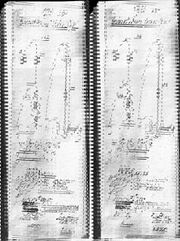
Henry Woodward (inventor)
Encyclopedia

Canada
Canada is a North American country consisting of ten provinces and three territories. Located in the northern part of the continent, it extends from the Atlantic Ocean in the east to the Pacific Ocean in the west, and northward into the Arctic Ocean...
inventor and a major pioneer in the development of the incandescent lamp.
Work on the incandescent light bulb
On July 24, 1874, Woodward and his partner, Mathew EvansMathew Evans
Mathew Evans is one of two Canadians who developed and patented an incandescent light bulb, on July 24, 1874, five years before Thomas Alva Edison's U.S...
, a hotel keeper, patent
Patent
A patent is a form of intellectual property. It consists of a set of exclusive rights granted by a sovereign state to an inventor or their assignee for a limited period of time in exchange for the public disclosure of an invention....
ed an electric light bulb. Woodward was a medical student at the time. Their light bulb comprised a glass tube with a large piece of carbon connected to two wires. They filled the tube with inert nitrogen
Nitrogen
Nitrogen is a chemical element that has the symbol N, atomic number of 7 and atomic mass 14.00674 u. Elemental nitrogen is a colorless, odorless, tasteless, and mostly inert diatomic gas at standard conditions, constituting 78.08% by volume of Earth's atmosphere...
to get a longer burn life in the filament. Their light bulb was fully effective and sufficiently promising; they sold their to Thomas Edison
Thomas Edison
Thomas Alva Edison was an American inventor and businessman. He developed many devices that greatly influenced life around the world, including the phonograph, the motion picture camera, and a long-lasting, practical electric light bulb. In addition, he created the world’s first industrial...
. Thomas Edison obtained an exclusive license to the Canadian patent. Thomas Edison developed his own design of incandescent lamp with a high resistance thin filament of carbon in a high vacuum contained in a tightly sealed glass bulb which had a sufficiently long service life to be commercially practical.
The relationship of the Woodward/Evans work on the incandescent bulb that of others, including Edison, on electric light is explained in the following passage of an article in a 1900 issue of Electrical World and Engineer as follows:
"The first incandescent lamp [developed by Woodward and Evans] was constructed at Morrison's brass foundry in Toronto, and was a very crude affair. It consisted of a water gauge glass with a piece of carbon, filed by hand and drilled at each end, for the electrodes, and hermetically sealed at both ends, having a petcock at one end with a brass tube to exhaust the air. Woodward made the mistake of filling the tube or globe of this lamp with nitrogen after having exhausted the air. Prof. Elihu Thomson is quoted as having said that had he stopped when he had the tube exhausted he would have had the honor of being the inventor of the incandescent light as used for commercial purposes... the principle of the incandescent lamp dates several decades before the Woodward experiments, and that King, Chanzy, Farmer and others in the twenty years preceding 1860 made and used incandescent lamps much superior to the very imperfect one upon which Woodward's claims are based. Moreover, the Edison claims, as sustained in the courts, were not on the discovery of the principles of the incandescent lamp but on a definite combination of parts—all well known—which resulted in the production of a practical form of the incandescent lamp."
The drawings from Woodward's 1876 United States patent are almost identical to those that appeared in Woodward and Evan's 1874 Canadian patent. The carbon burner, a "most important feature of a practical lamp" differs widely from Edison's filament. Several earlier inventors working on the light bulb had progressed as far in their work as Woodward and Evans: J. B. A. M. Jobard in 1838, C. de Changy in 1856, John Wellington Starr
John Wellington Starr
John Wellington Starr was an American inventor and pioneer in development of the incandescent light bulb. Starr was born in Cincinnati. In 1844, in association with John Milton Sanders , Starr filed a U. S. patent caveat for an incandescent lamp and generator.Starr appears never to have...
in 1845 and Joseph Swan
Joseph Swan
Sir Joseph Wilson Swan was a British physicist and chemist, most famous for the invention of the incandescent light bulb for which he received the first patent in 1878...
in 1860. Each contributed to the development of the incandescent lamp, but it was Edison who assembled the necessary components to make the first practical electric light bulb.
What is known about Woodward's discovery is that it was patented in Canada and the United States prior to a patent being granted to Edison and it is known that the patent for the Canadian discovery was purchased by Edison when he was making his original investigations and before he obtained his patent.
Further reading
- Black, Harry (1997). Canadian Scientists and Inventors. Markham, Ontario: Pembroke Publishers.
- Hughes, Susan (2002). Canada Invents, Toronto: Owl Books.
- Boulet, Daniel. Woodward and Evan's Light - patented July 24, 1874. Reproduction of Woodward and Evans' patent.

